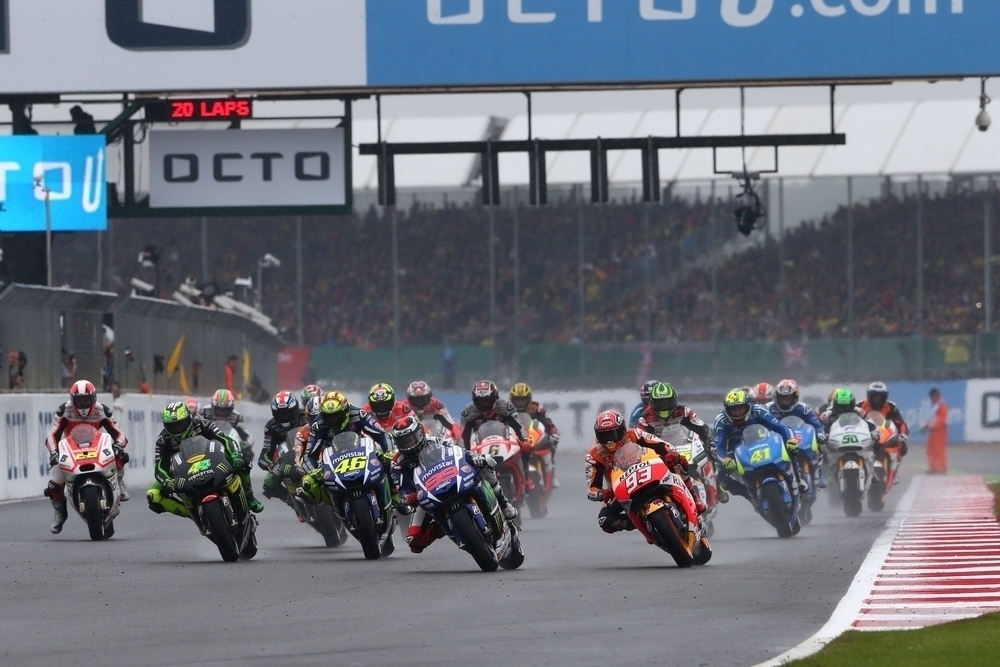British MotoGP™ debrief with Shinji Aoki
Tuesday, September 1 2015
Bridgestone slick options: Front: Extra-soft, Soft & Medium; Rear: Soft, Medium & Hard (Asymmetric)
Bridgestone wet tyre options: Soft (Main), Hard (Alternative)
The 2015 British Grand Prix was won in dramatic style by Movistar Yamaha MotoGP’s Valentino Rossi who mastered the wet conditions at Silverstone to win ahead of Danilo Petrucci and Andrea Dovizioso.
A dry race was on the cards until a late change in the weather resulted in all riders riding into pit lane during the warm up lap to swap to their bikes fitted with wet tyres, resulting in race control deciding to restart the race. In the end all riders started and completed the race on the soft compound wet tyres front and rear as the rain continued for the full duration of the British Grand Prix.
Q&A with Shinji Aoki – Manager, Bridgestone Motorcycle Tyre Development Department
Last Sunday’s British Grand Prix was the first completely wet race since the 2013 French Grand Prix. As it was the first opportunity in a long time for riders to use rain tyres in fully wet conditions, what was the feedback you got from the riders on wet tyre performance at Silverstone?
“Overall the riders were happy with the performance of our wet tyres during the race and I think that the fact that it was raining during the Sunday morning Warm Up session was a big bonus. The wet Warm Up session allowed the teams to work on their bike settings for wet conditions which enabled the riders to better manage their tyres over race distance. Another factor which riders often mention is the consistent performance and quality of our BATTLAX MotoGP wet tyres, as the familiar feedback they get from our wet tyres from one set to the other means that even if has been a long time since they have ridden in the rain, if their bike is set up well it doesn’t take long to get comfortable riding in wet conditions. This consistency is important not just for performance, but also for rider safety.”
All riders selected the soft compound wet tyres front and rear for the race. Are you surprised that no riders went for the hard option wet tyres to try and gain an advantage at the end of the race?
“It is true that if the towards the end of the race the track begun to dry that perhaps the hard compound wet tyres could provide an advantage, but given the cold track temperatures and constant rain the soft compound wet tyres were the logical choice. Our experience shows that when it rains at Silverstone it is also very cool and the grip level isn’t as good in wet conditions as some other circuits and this is why we specified the soft wet tyres as the main option at this race. When the rain started to fall before the race and the riders were in discussion with our engineers on the grid, some riders were asking the question on whether to run the hard compound wet tyre but ultimately, all riders followed our recommendation and used the soft wet option front and rear. I believe this was the right decision as when you consider the bumpy nature of the Silverstone tarmac and the cool temperatures we had, having wet tyres with the highest amount of grip possible is the safest option.”
The race was wet but for the first two days of the race weekend conditions were dry. What can you say about the performance of Bridgestone’s slick tyres at Silverstone this year?
“Although the wet race on Sunday was exciting to watch, I was somewhat disappointed that we had wet conditions as I wanted to see how our 2015 specification slick tyres would have performed over twenty laps at Silverstone. The pace during free practice and qualifying was very quick with many riders able to consistently lap under race record pace and Marc also smashing the Silverstone Circuit Best Lap record during qualifying. What we could see during the dry sessions was that all three of our rear slick options were viable race options depending on the track temperature and for the front tyre, the increased bumps in some corners this year meant that the soft compound front slick was the best performing option as it provided good braking and cornering performance with favourable bump absorption.”






